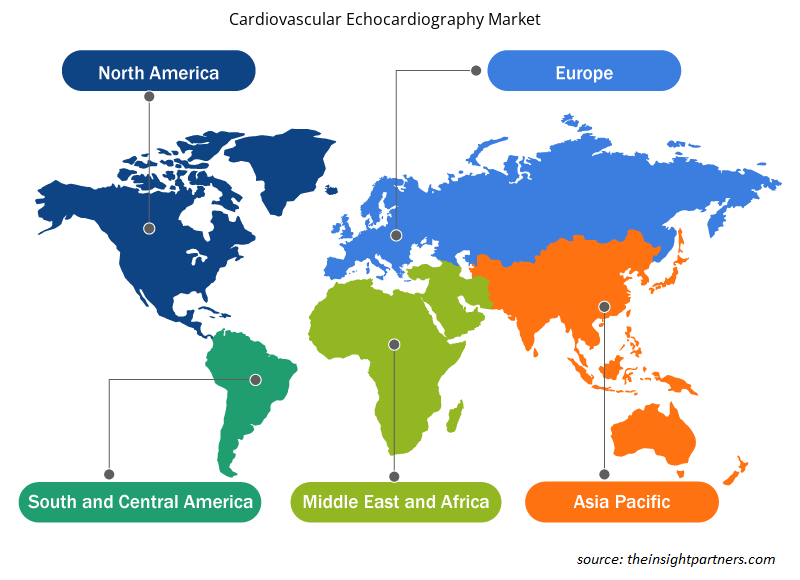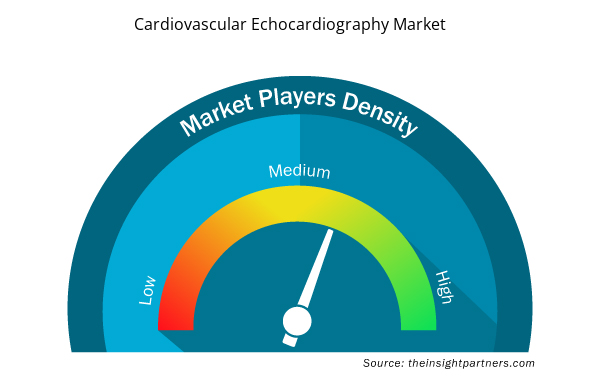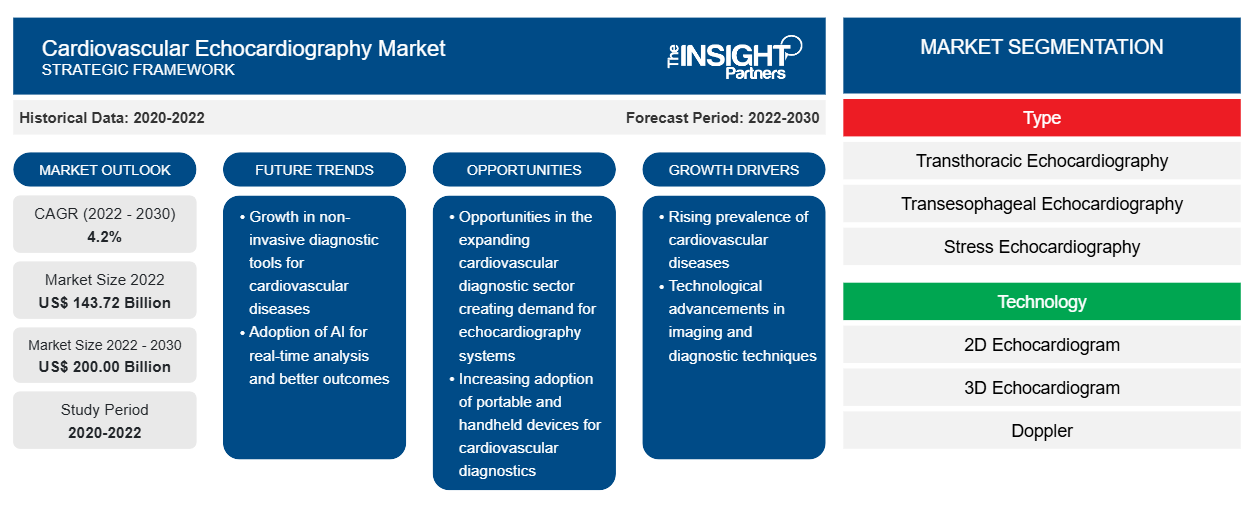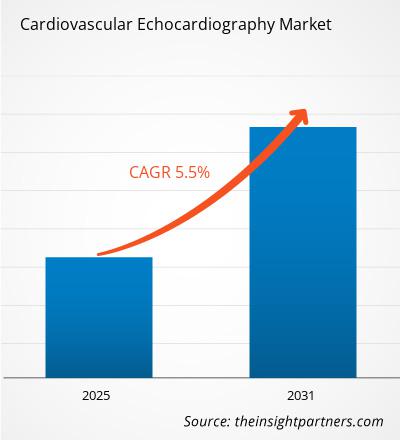[Rapport de recherche] La taille du marché de l'échocardiographie cardiovasculaire devrait atteindre 200,00 milliards USD d'ici 2030, contre 143,72 milliards USD en 2022 ; le marché devrait enregistrer un TCAC de 4,2 % au cours de la période 2022-2030.
Informations sur le marché et point de vue des analystes :
L'échocardiographie cardiovasculaire est un type d'imagerie médicale permettant d'examiner le cœur. Elle utilise des ondes sonores pour créer des images visuelles du cœur. Cette procédure de test est généralement effectuée sur des patients présentant des maladies cardiaques suspectées ou connues. En plus de révéler la taille et la forme des cavités et des valves, le test estime également le fonctionnement du cœur en calculant le débit cardiaque, la fraction d'éjection et la fonction diastolique. L'échocardiogramme cardiovasculaire peut également détecter les cardiomyopathies. Les blessures causées par la crise cardiaque antérieure peuvent être clairement visualisées à l'aide d'échocardiographes. L'échographie cardiaque transthoracique, transoesophagienne et de stress fait partie des différents tests d'échographie cardiaque effectués à des fins de diagnostic. La charge croissante des maladies cardiovasculaires et la croissance de la population gériatrique devraient créer de nombreuses opportunités de croissance du marché de l'échocardiographie cardiovasculaire .
Moteurs de croissance :
Lors de l'examen et de l'évaluation d'une crise cardiaque, d'une douleur thoracique, d'une maladie coronarienne, de caillots sanguins et d'autres troubles cardiaques, les médecins recommandent des traitements invasifs qui impliquent des analyses de sang et un cathétérisme cardiaque. Le cathétérisme cardiaque nécessite une hospitalisation prolongée et entraîne certains effets secondaires tels que des saignements, des caillots sanguins, des lésions artérielles et d'autres complications. Pour ces raisons, les médecins limitent généralement l'utilisation de cette procédure pour le diagnostic cardiaque et ont plutôt recours à l'épreuve de stress cardiaque nucléaire, à l'imagerie par résonance magnétique , à l'échographie cardiaque et à l'angiographie coronarienne par tomodensitométrie, car ces procédures sont réalisées de manière non invasive.
L'échocardiographie est l'examen de diagnostic cardiovasculaire le plus couramment utilisé après l'électrocardiographie et la radiographie pulmonaire. Il s'agit d'une procédure de diagnostic non invasive qui révèle des informations sur le fonctionnement cardiaque et l'hémodynamique. Étant donné que les risques associés aux échocardiogrammes sont minimes, voire nuls, par rapport aux autres procédures de diagnostic qui utilisent des radiations pour produire des résultats, on constate une large adoption de ces appareils dans les hôpitaux et les centres de diagnostic. De plus, les patients ayant des antécédents d'insuffisance cardiaque bénéficient d'une surveillance de routine avec ces diagnostics de maladies cardiaques. Cela permet également de surveiller la maladie et l'efficacité du traitement ou de la chirurgie. Les échocardiogrammes sont également utilisés dans les soins infirmiers réguliers des patients subissant un traitement contre le cancer et présentant un risque de cardiotoxicité.
Les avantages associés à l’utilisation d’appareils échocardiographiques par rapport à d’autres procédures de diagnostic cardiaque favorisent son adoption, stimulant ainsi la croissance du marché de l’échocardiographie cardiovasculaire.
Les tendances du marché de l’échocardiographie cardiovasculaire incluent l’intégration de l’IA et d’autres technologies innovantes dans les appareils d’échocardiographie.
Personnalisez ce rapport en fonction de vos besoins
Vous bénéficierez d'une personnalisation gratuite de n'importe quel rapport, y compris de certaines parties de ce rapport, d'une analyse au niveau des pays, d'un pack de données Excel, ainsi que d'offres et de remises exceptionnelles pour les start-ups et les universités.
- Obtenez les principales tendances clés du marché de ce rapport.Cet échantillon GRATUIT comprendra une analyse de données, allant des tendances du marché aux estimations et prévisions.
Segmentation et portée du rapport :
L'analyse du marché de l'échocardiographie cardiovasculaire a été réalisée en prenant en compte les segments suivants : type, technologie, utilisateur final et géographie. En fonction du type, le marché est segmenté en échocardiographie transthoracique, échocardiographie transœsophagienne, échocardiographie de stress et échocardiographie fœtale. En termes de technologie, le marché est classé en échocardiogramme 2D, échocardiogramme 3D et Doppler. En fonction de l'utilisateur final, le marché est classé en hôpitaux, centres de chirurgie ambulatoire et laboratoires de diagnostic. La portée du rapport sur le marché de l'échocardiographie cardiovasculaire couvre l'Amérique du Nord (États-Unis, Canada et Mexique), l'Europe (France, Allemagne, Royaume-Uni, Espagne, Italie et reste de l'Europe), l'Asie-Pacifique (Chine, Japon, Inde, Australie, Corée du Sud et reste de l'Asie-Pacifique), le Moyen-Orient et l'Afrique (Arabie saoudite, Afrique du Sud, Émirats arabes unis et reste du Moyen-Orient et de l'Afrique) et l'Amérique du Sud et centrale (Brésil, Argentine et reste de l'Amérique du Sud et centrale).
Analyse segmentaire :
Le marché de l'échocardiographie cardiovasculaire, par type, est classé en échocardiographie transthoracique, échocardiographie de stress, échocardiographie transœsophagienne et échocardiographie fœtale. Le segment de l'échocardiographie transthoracique détenait une part de marché importante en 2022. Il devrait enregistrer le TCAC le plus élevé du marché au cours de la période 2022-2030.
En fonction de la technologie, le marché est classé en échocardiogramme 2D, échocardiogramme 3D et Doppler. Le segment de l'échocardiogramme 3D détenait une part de marché importante de l'échocardiographie cardiovasculaire en 2022 et devrait enregistrer le TCAC le plus élevé au cours de la période 2022-2030.
En fonction de l'utilisateur final, le marché est segmenté en hôpitaux, centres de chirurgie ambulatoire et laboratoires de diagnostic. Le segment des hôpitaux détenait une part de marché importante de l'échocardiographie cardiovasculaire en 2022 et devrait enregistrer le TCAC le plus élevé au cours de la période 2022-2030.
Aperçu régional du marché de l'échocardiographie cardiovasculaire
Les tendances et facteurs régionaux influençant le marché de l’échocardiographie cardiovasculaire tout au long de la période de prévision ont été expliqués en détail par les analystes d’Insight Partners. Cette section traite également des segments et de la géographie du marché de l’échocardiographie cardiovasculaire en Amérique du Nord, en Europe, en Asie-Pacifique, au Moyen-Orient et en Afrique, ainsi qu’en Amérique du Sud et en Amérique centrale.

- Obtenez les données régionales spécifiques au marché de l'échocardiographie cardiovasculaire
Portée du rapport sur le marché de l'échocardiographie cardiovasculaire
| Attribut de rapport | Détails |
|---|---|
| Taille du marché en 2022 | 143,72 milliards de dollars américains |
| Taille du marché d'ici 2030 | 200,00 milliards de dollars américains |
| Taux de croissance annuel moyen mondial (2022-2030) | 4,2% |
| Données historiques | 2020-2022 |
| Période de prévision | 2022-2030 |
| Segments couverts | Par type
|
| Régions et pays couverts | Amérique du Nord
|
| Leaders du marché et profils d'entreprises clés |
|
Densité des acteurs du marché de l'échocardiographie cardiovasculaire : comprendre son impact sur la dynamique commerciale
Le marché de l'échocardiographie cardiovasculaire connaît une croissance rapide, tirée par la demande croissante des utilisateurs finaux en raison de facteurs tels que l'évolution des préférences des consommateurs, les avancées technologiques et une plus grande sensibilisation aux avantages du produit. À mesure que la demande augmente, les entreprises élargissent leurs offres, innovent pour répondre aux besoins des consommateurs et capitalisent sur les tendances émergentes, ce qui alimente davantage la croissance du marché.
La densité des acteurs du marché fait référence à la répartition des entreprises ou des sociétés opérant sur un marché ou un secteur particulier. Elle indique le nombre de concurrents (acteurs du marché) présents sur un marché donné par rapport à sa taille ou à sa valeur marchande totale.
Les principales entreprises opérant sur le marché de l'échocardiographie cardiovasculaire sont :
- Apex Cœur et système vasculaire
- Imagerie Ultra-X
- Institut métropolitain de cardiologie vasculaire
- Ultromics Limitée
- Santé Corewell
Avis de non-responsabilité : les sociétés répertoriées ci-dessus ne sont pas classées dans un ordre particulier.

- Obtenez un aperçu des principaux acteurs du marché de l'échocardiographie cardiovasculaire
Analyse régionale :
Géographiquement, le marché de l'échocardiographie cardiovasculaire est segmenté en Amérique du Nord, Europe, Asie-Pacifique, Amérique du Sud et centrale, Moyen-Orient et Afrique. En 2022, l'Amérique du Nord a conquis une part importante du marché. En 2022, les États-Unis ont dominé le marché dans cette région. La croissance du marché en Amérique du Nord est attribuée à l'augmentation de l'incidence des maladies cardiaques, à l'augmentation de la population gériatrique et à la présence d'acteurs clés du marché dans la région.
Les maladies cardiaques sont l’une des principales causes de décès aux États-Unis. Selon les Centers for Disease Control and Prevention (CDC), environ 805 000 personnes sont victimes d’une crise cardiaque aux États-Unis chaque année. En outre, les maladies coronariennes sont le type de maladie cardiaque le plus courant, qui a entraîné le décès de 360 900 personnes en 2019. Selon les CDC, on estime que 12,1 millions de personnes aux États-Unis souffriront de fibrillation auriculaire en 2030. De même, selon le Système canadien de surveillance des maladies chroniques, environ 1 adulte canadien sur 12 (2,6 millions) âgé de 20 ans et plus vit avec une maladie cardiaque diagnostiquée dans le pays. Selon Statistique Canada, 67 399 personnes sont décédées des suites d’une maladie cardiaque ou d’un accident vasculaire cérébral en 2020. Ainsi, le nombre croissant de maladies cardiovasculaires affecte une taille de population considérable. Cela conduit à une demande accrue d’outils de diagnostic, tels que l’échocardiographie cardiovasculaire, pour évaluer et surveiller la santé cardiovasculaire, propulsant ainsi le marché de l’échocardiographie cardiovasculaire dans la région.
Paysage concurrentiel et entreprises clés :
Les prévisions du marché de l’échocardiographie cardiovasculaire peuvent aider les parties prenantes à planifier leurs stratégies de croissance. Apex Heart and Vascular, Ultra-X Imaging, Metropolitan Heart Vascular Institute, Ultromics Limited, Corewell Health, Centinela Hospital Medical Center, Schoolcraft Memorial Hospital, University of Utah Health, Goshen Heart & Vascular Center et Harefield Hospital font partie des principaux acteurs présentés dans le rapport sur le marché de l’échocardiographie cardiovasculaire. Ces entreprises se concentrent sur l’introduction de nouveaux produits de haute technologie, les avancées des produits existants et les expansions géographiques pour répondre à la demande croissante des consommateurs dans le monde entier.
- Analyse historique (2 ans), année de base, prévision (7 ans) avec TCAC
- Analyse PEST et SWO
- Taille du marché Valeur / Volume - Mondial, Régional, Pays
- Industrie et paysage concurrentiel
- Ensemble de données Excel


- E-Bike Market
- Tortilla Market
- Foot Orthotic Insoles Market
- Medical Collagen Market
- Social Employee Recognition System Market
- Dry Eye Products Market
- Excimer & Femtosecond Ophthalmic Lasers Market
- Identity Verification Market
- Digital Language Learning Market
- Lyophilization Services for Biopharmaceuticals Market

Report Coverage
Revenue forecast, Company Analysis, Industry landscape, Growth factors, and Trends

Segment Covered
This text is related
to segments covered.

Regional Scope
North America, Europe, Asia Pacific, Middle East & Africa, South & Central America

Country Scope
This text is related
to country scope.
Questions fréquemment posées
The global cardiovascular echocardiography market is segmented based on type, technology, and end user. The cardiovascular echocardiography market, by type, is categorized into transthoracic echocardiography, transesophageal echocardiography, stress echocardiography, and fetal echocardiography. The transthoracic echocardiography segment held a significant market share in 2022 and is anticipated to record the highest CAGR in the market during 2022–2030.
The cardiovascular echocardiography market was valued at US$ 143.72 billion in 2022.
The cardiovascular echocardiography market is expected to be valued at US$ 200.00 billion in 2030.
Echocardiography is an extensive medical procedure using sound waves to produce real-time images of the heart. The image is called an echocardiogram. It enables the physician to keep an eye on the heart's and valves' functioning. The echocardiographs are a useful tool for visualizing the wounds from the prior heart attack. Transthoracic, transesophageal, and stress cardiac echocardiography are among the different cardiac echocardiography examinations that are utilized for different diagnostic procedures.
The factors driving the growth of the cardiovascular echocardiography market include the rising burden of cardiovascular diseases and the advantages of echocardiographic devices over other cardiac diagnostic procedures. However, challenges associated with the use of echocardiography devices hampers the growth of the cardiovascular echocardiography market.
The cardiovascular echocardiography market majorly consists of the players, including Apex Heart and Vascular, Ultra-X Imaging, Metropolitan Heart Vascular Institute, Ultromics Limited, Corewell Health, Centinela Hospital Medical Center, Schoolcraft Memorial Hospital, University of Utah Health, Goshen Heart & Vascular Center, and Harefield Hospital.
Trends and growth analysis reports related to Life Sciences : READ MORE..
The List of Companies - Cardiovascular Echocardiography Market
- Apex Heart and Vascular
- Ultra-X Imaging
- Metropolitan Heart Vascular Institute
- Ultromics Limited
- Corewell Health
- Centinela Hospital Medical Center
- Schoolcraft Memorial Hospital
- University of Utah Health
- Goshen Heart & Vascular Center
- Harefield Hospital
The Insight Partners performs research in 4 major stages: Data Collection & Secondary Research, Primary Research, Data Analysis and Data Triangulation & Final Review.
- Data Collection and Secondary Research:
As a market research and consulting firm operating from a decade, we have published and advised several client across the globe. First step for any study will start with an assessment of currently available data and insights from existing reports. Further, historical and current market information is collected from Investor Presentations, Annual Reports, SEC Filings, etc., and other information related to company’s performance and market positioning are gathered from Paid Databases (Factiva, Hoovers, and Reuters) and various other publications available in public domain.
Several associations trade associates, technical forums, institutes, societies and organization are accessed to gain technical as well as market related insights through their publications such as research papers, blogs and press releases related to the studies are referred to get cues about the market. Further, white papers, journals, magazines, and other news articles published in last 3 years are scrutinized and analyzed to understand the current market trends.
- Primary Research:
The primarily interview analysis comprise of data obtained from industry participants interview and answers to survey questions gathered by in-house primary team.
For primary research, interviews are conducted with industry experts/CEOs/Marketing Managers/VPs/Subject Matter Experts from both demand and supply side to get a 360-degree view of the market. The primary team conducts several interviews based on the complexity of the markets to understand the various market trends and dynamics which makes research more credible and precise.
A typical research interview fulfils the following functions:
- Provides first-hand information on the market size, market trends, growth trends, competitive landscape, and outlook
- Validates and strengthens in-house secondary research findings
- Develops the analysis team’s expertise and market understanding
Primary research involves email interactions and telephone interviews for each market, category, segment, and sub-segment across geographies. The participants who typically take part in such a process include, but are not limited to:
- Industry participants: VPs, business development managers, market intelligence managers and national sales managers
- Outside experts: Valuation experts, research analysts and key opinion leaders specializing in the electronics and semiconductor industry.
Below is the breakup of our primary respondents by company, designation, and region:

Once we receive the confirmation from primary research sources or primary respondents, we finalize the base year market estimation and forecast the data as per the macroeconomic and microeconomic factors assessed during data collection.
- Data Analysis:
Once data is validated through both secondary as well as primary respondents, we finalize the market estimations by hypothesis formulation and factor analysis at regional and country level.
- Macro-Economic Factor Analysis:
We analyse macroeconomic indicators such the gross domestic product (GDP), increase in the demand for goods and services across industries, technological advancement, regional economic growth, governmental policies, the influence of COVID-19, PEST analysis, and other aspects. This analysis aids in setting benchmarks for various nations/regions and approximating market splits. Additionally, the general trend of the aforementioned components aid in determining the market's development possibilities.
- Country Level Data:
Various factors that are especially aligned to the country are taken into account to determine the market size for a certain area and country, including the presence of vendors, such as headquarters and offices, the country's GDP, demand patterns, and industry growth. To comprehend the market dynamics for the nation, a number of growth variables, inhibitors, application areas, and current market trends are researched. The aforementioned elements aid in determining the country's overall market's growth potential.
- Company Profile:
The “Table of Contents” is formulated by listing and analyzing more than 25 - 30 companies operating in the market ecosystem across geographies. However, we profile only 10 companies as a standard practice in our syndicate reports. These 10 companies comprise leading, emerging, and regional players. Nonetheless, our analysis is not restricted to the 10 listed companies, we also analyze other companies present in the market to develop a holistic view and understand the prevailing trends. The “Company Profiles” section in the report covers key facts, business description, products & services, financial information, SWOT analysis, and key developments. The financial information presented is extracted from the annual reports and official documents of the publicly listed companies. Upon collecting the information for the sections of respective companies, we verify them via various primary sources and then compile the data in respective company profiles. The company level information helps us in deriving the base number as well as in forecasting the market size.
- Developing Base Number:
Aggregation of sales statistics (2020-2022) and macro-economic factor, and other secondary and primary research insights are utilized to arrive at base number and related market shares for 2022. The data gaps are identified in this step and relevant market data is analyzed, collected from paid primary interviews or databases. On finalizing the base year market size, forecasts are developed on the basis of macro-economic, industry and market growth factors and company level analysis.
- Data Triangulation and Final Review:
The market findings and base year market size calculations are validated from supply as well as demand side. Demand side validations are based on macro-economic factor analysis and benchmarks for respective regions and countries. In case of supply side validations, revenues of major companies are estimated (in case not available) based on industry benchmark, approximate number of employees, product portfolio, and primary interviews revenues are gathered. Further revenue from target product/service segment is assessed to avoid overshooting of market statistics. In case of heavy deviations between supply and demand side values, all thes steps are repeated to achieve synchronization.
We follow an iterative model, wherein we share our research findings with Subject Matter Experts (SME’s) and Key Opinion Leaders (KOLs) until consensus view of the market is not formulated – this model negates any drastic deviation in the opinions of experts. Only validated and universally acceptable research findings are quoted in our reports.
We have important check points that we use to validate our research findings – which we call – data triangulation, where we validate the information, we generate from secondary sources with primary interviews and then we re-validate with our internal data bases and Subject matter experts. This comprehensive model enables us to deliver high quality, reliable data in shortest possible time.


 Obtenez un échantillon gratuit pour ce rapport
Obtenez un échantillon gratuit pour ce rapport